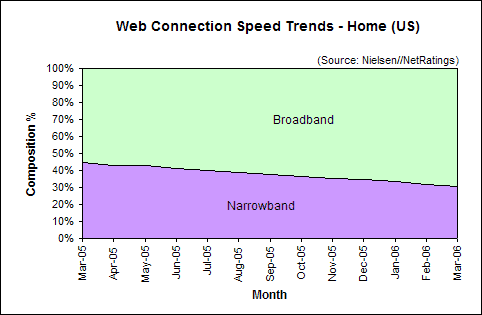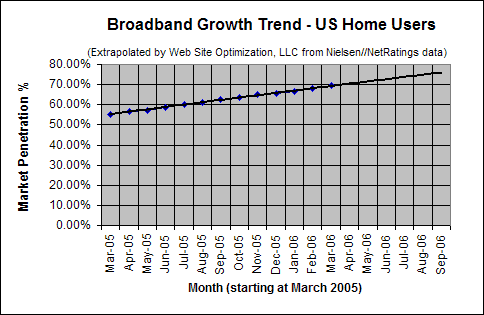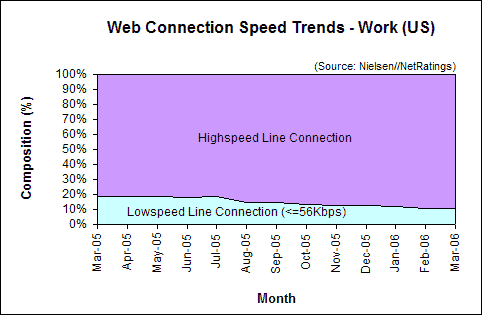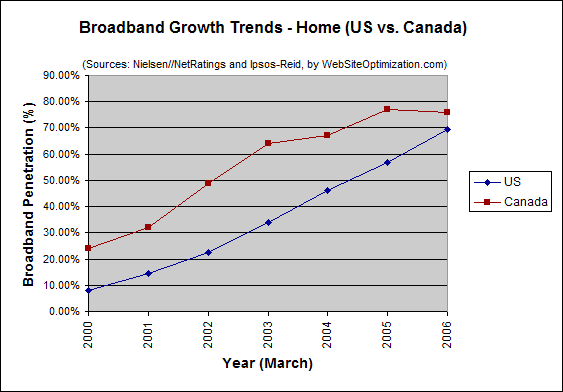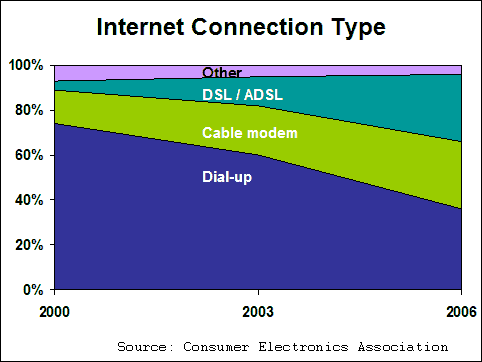US broadband penetration jumped 1.39 percentage points in March 2006 to 69.39% among active Internet users. Broadband penetration should easily break 70% by April 2006. Over the past year, the broadband gap between Canada and the US has narrowed from 20 percentage points to 6.6 percentage points. Since last March, US broadband penetration rose 12.4 percentage points while Canadian broadband penetration was flat.
Home Connectivity in the US
US broadband penetration grew to 69.39% in March 2006. Narrowband users (56Kbps or less) now comprise 30.61% of active Internet users, down 1.39 percentage points from 32% in February (see Figure 1).
Web Connection Speed Trends – Home Users (US)
Figure 1: Web Connection Speed Trends – Home Users (US)
Source: Nielsen//NetRatings
Broadband Growth Trends in the US
In March 2006, broadband penetration in US homes rose 1.39 percentage points to 69.39% up from 68% in February. This increase of 1.39 points is higher than the average increase in broadband of 1.11 points per month over the last six months. At the current growth rate, broadband penetration among active Internet users in US homes should easily break 70% by April 2006 (see Figure 2).
Broadband Adoption Growth Trend – Home Users (US)
Figure 2: Broadband Adoption Growth Trend – Home Users (US)
Extrapolated from Nielsen//NetRatings data
Work Connectivity
Most workers in the US enjoy high-speed connections to the Internet. Most use a high-speed line such as a T1 connection, and share bandwidth between computers connected to an Ethernet network. The speed of each connection decreases as more employees hook up to the LAN. As of March 2006, of those connected to the Internet, 89.13% of US users at work enjoy a high-speed connection, up 0.06 percentage points from the 89.07% share in February. At work, 10.87% connect at 56Kbps or less (see Figure 3).
Web Connection Speed Trends – Work Users (US)
Figure 3: Web Connection Speed Trends – Work Users (US)
Source: Nielsen//NetRatings
US-Canadian Broadband Gap Narrows
The gap between the US and Canada in broadband penetration is closing, according to our annual survey. Canadian broadband penetration actually fell slightly to 76% in March 2006 from 77% in March 2005 (within the margin of error). Meanwhile the US surged by 12.4 percentage points to 69.4%, closing the gap from 20 percentage points a year ago to 6.6 percentage points (see Figure 4).
US versus Canadian Broadband Penetration Over Time
Figure 4: US versus Canadian Broadband Penetration Over Time
Source: Ipsos-Reid and Nielsen//NetRatings
Cable losing lead to DSL Internet Service
In a survey of US households with Internet access, the Consumer Electronics Association found that dial-up usage has halved in the last six years from 74% in October 2000 to 36% in March 2006. Naturally enough, broadband adoption has followed an opposite trend, growing from one-fifth of the market in October 2000 to 64% in March 2006. Cable has lost its lead over DSL over the past six years. In October 2000 Cable had a 15% share compared to 4% for DSL. In March 2006 they were tied at 30% each (see Figure 5 and Table 1). Leichtman Research has cable still in the lead, with their latest numbers being 52% cable, 46% DSL and 2% other (March 2006 preliminary data)
US versus Canadian Broadband Penetration Over Time
Figure 5: Internet Connections by Type
Source: Consumer Electronics Association, “Broadband and the Home of Tomorrow –
March 2006,” used with permission
| Month/Year | Dial-up | Cable modem | DSL or ADSL | Other |
|---|---|---|---|---|
| March 2006 | 36% | 30% | 30% | 4% |
| July 2003 | 60% | 22% | 13% | 5% |
| October 2000 | 74% | 15% | 4% | 7% |
Further Reading
- Ipsos-Reid
- Provides the Canadian broadband penetration data for the Bandwidth Report.
- Leichman Research
- The latest cable versus DSL report from Leichtman Research, March results pending.
- Nielsen//NetRatings
- Provided the streaming media player and US broadband data for the Bandwidth Report.
- OECD Broadband Statistics, December 2005
- Iceland, Korea, the Netherlands and Denmark lead all OECD countries in broadband penetration.
*Note that Nielsen//NetRatings NetSpeed report determines the connection speeds of the Digital Media Universe, which combines Web traffic, Internet applications and proprietary channels. The streaming media player data used in this report was from NetRatings’ NetView service, which pulls usage from the same panel as the NetSpeed data. The NetView service is based on Nielsen’s RDD panel of about 30,000 home/work panelists in the U.S.
The Bandwidth Report is featured monthly on URLwire – news of useful and unique web content since 1994.

